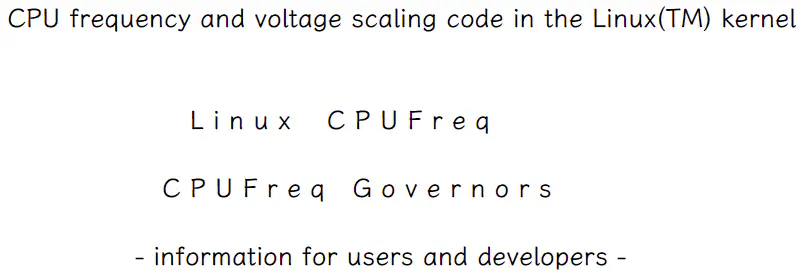performance governor 工作原理
上层修改scaling_max/min_freq时,内核发生了什么
 Image credit: Unsplash
Image credit: Unsplash先将所有事情准备好:cpufreq_policy_alloc
内核启动时为CPU核心注册driver,层层调用cpufreq_register_driver->cpuhp_cpufreq_online->cpufreq_online->cpufreq_policy_alloc函数。该函数初始化policy很多信息,其中比较重要的是下面初始化了update函数。
policy->nb_min.notifier_call = cpufreq_notifier_min;
policy->nb_max.notifier_call = cpufreq_notifier_max;
INIT_WORK(&policy->update, handle_update);
static int cpufreq_notifier_min(struct notifier_block *nb, unsigned long freq,
void *data)
{
struct cpufreq_policy *policy = container_of(nb, struct cpufreq_policy, nb_min);
schedule_work(&policy->update);
return 0;
}
其中handle_update函数调用了refresh_frequency_limits()函数,用于更新频率的min和max值。
static void handle_update(struct work_struct *work)
{
struct cpufreq_policy *policy =
container_of(work, struct cpufreq_policy, update);
pr_debug("handle_update for cpu %u called\n", policy->cpu);
down_write(&policy->rwsem);
refresh_frequency_limits(policy);
up_write(&policy->rwsem);
}
refresh_frequency_limits调用逻辑为调用cpufreq_set_policy->cpufreq_governor_limits()
static int cpufreq_set_policy(struct cpufreq_policy *policy,
struct cpufreq_governor *new_gov,
unsigned int new_pol)
{
...
if (new_gov == policy->governor) {
pr_debug("governor limits update\n");
cpufreq_governor_limits(policy);
return 0;
}
...
}
cpufreq_governor_limits函数体如下,它会调用governor的limits函数。
static void cpufreq_governor_limits(struct cpufreq_policy *policy)
{
if (cpufreq_suspended || !policy->governor)
return;
pr_debug("%s: for CPU %u\n", __func__, policy->cpu);
if (policy->governor->limits)
policy->governor->limits(policy);
}
我们以performance为例,其中hook了limits函数,用于调用自己的cpufreq_gov_performance_limits函数,修改cpu频率。
static void cpufreq_gov_performance_limits(struct cpufreq_policy *policy)
{
pr_debug("setting to %u kHz\n", policy->max);
__cpufreq_driver_target(policy, policy->max, CPUFREQ_RELATION_H);
}
static struct cpufreq_governor cpufreq_gov_performance = {
.name = "performance",
.owner = THIS_MODULE,
.flags = CPUFREQ_GOV_STRICT_TARGET,
.limits = cpufreq_gov_performance_limits,
};
当修改scaling_max_freq的时候发生了什么
由上面我们知道了如果调用update函数,performance governor会根据最大值也就是scaling_max_freq的值修改cpu频率,但是scaling_max_freq是如何传入内核,且触发update函数的呢?
答案就是hook读写文件的函数,当读写文件时调用函数修改内核变量,触发更新函数。在cpufreq.c中存在非常多将文件名和函数名关联起来的的定义
#define cpufreq_freq_attr_rw(_name) \
static struct freq_attr _name = \
__ATTR(_name, 0644, show_##_name, store_##_name)
cpufreq_freq_attr_rw(scaling_min_freq);
cpufreq_freq_attr_rw(scaling_max_freq);
cpufreq_freq_attr_rw(scaling_governor);
cpufreq_freq_attr_rw(scaling_setspeed);
在common/include/linux/sysfs.h中__ATTR定义了读写文件时调用了哪个show(读取)函数和store(写入)函数。
#define __ATTR(_name, _mode, _show, _store) { \
.attr = {.name = __stringify(_name), \
.mode = VERIFY_OCTAL_PERMISSIONS(_mode) }, \
.show = _show, \
.store = _store, \
}
cpufreq.c还有其他和sysfs有关的操作,和我们分析performance没太大关系,读者可以自行查看。上面我们发现scaling_max_freq和scaling_min_freq都被宏定义cpufreq_freq_attr_rw定义了读写函数,因此只需要找到store_scaling_max_freq和store_scaling_min_freq函数即可。
store_one(scaling_min_freq, min);
store_one(scaling_max_freq, max);
#define store_one(file_name, object) \
static ssize_t store_##file_name \
(struct cpufreq_policy *policy, const char *buf, size_t count) \
{ \
unsigned long val; \
int ret; \
\
ret = kstrtoul(buf, 0, &val); \
if (ret) \
return ret; \
\
ret = freq_qos_update_request(policy->object##_freq_req, val);\
return ret >= 0 ? count : ret; \
}
函数定义中调用freq_qos_update_request->freq_qos_apply->pm_qos_update_target函数
int pm_qos_update_target(struct pm_qos_constraints *c, struct plist_node *node,
enum pm_qos_req_action action, int value)
{
...
if (c->notifiers)
blocking_notifier_call_chain(c->notifiers, curr_value, NULL);
...
}
之后会调用前面的cpufreq_notifier_min函数,将之前注册好的handle_update函数通过schedule_work函数放入一个队列,当调用到handle_update函数时跟着上面的逻辑层层调用到limits函数,对cpu频率进行修改。
static int notifier_call_chain(struct notifier_block **nl,
unsigned long val, void *v,
int nr_to_call, int *nr_calls)
{
pm_qos_set_value(c, curr_value); //修改policy->max的值
...
ret = nb->notifier_call(nb, val, v); //调用回调函数,更新governor
...
}
What’s inside schedule_work?
TODO
总结
当我们通过echo xxx > /sys/devices/system/cpu/cpufreq/policy0/scaling_max_freq时发生了如下的事情
- echo程序底层实现使用write系统调用,write调用了sysfs中的store函数,该函数已经被hook为store_scaling_max_freq函数。
- store_scaling_max_freq函数修改policy->max的值,但此时cpu频率并不会因此而修改。之后调用之前该文件注册好的notifier_call,也就是cpufreq_notifier_max函数,该函数内部调用了 schedule_work(&policy->update);,其中update在INIT_WORK中注册为handle_update函数。schedule_work将函数指针放入队列,等待系统空闲时调用。
- handle_update函数得到调用,层层调用governor->limits函数,当governor为performance时,该函数指向cpufreq_gov_performance_limits,该函数最终调用__cpufreq_driver_target将cpu频率修改为policy->max的值。
Reference
- common/drivers/cpufreq/cpufreq.c